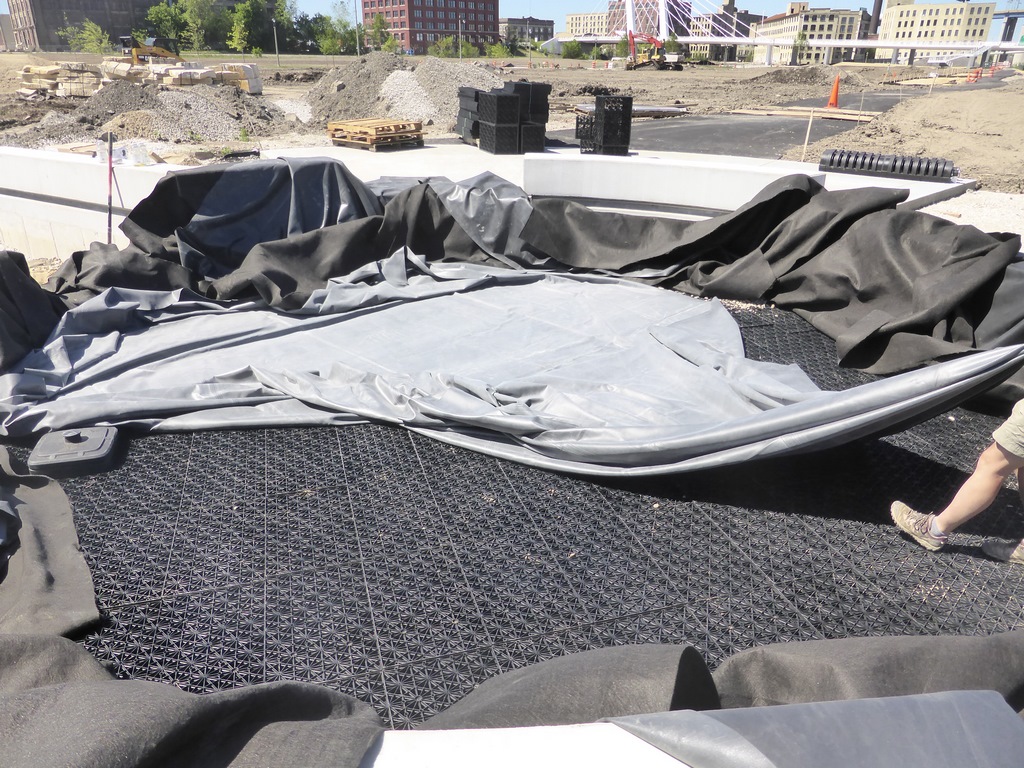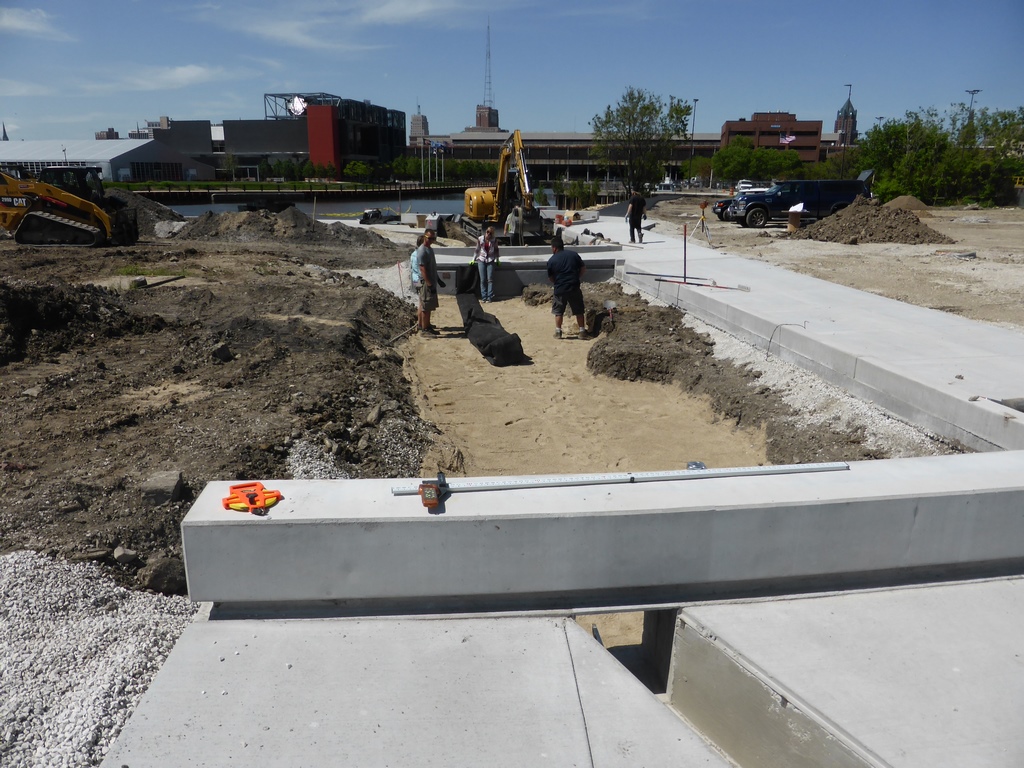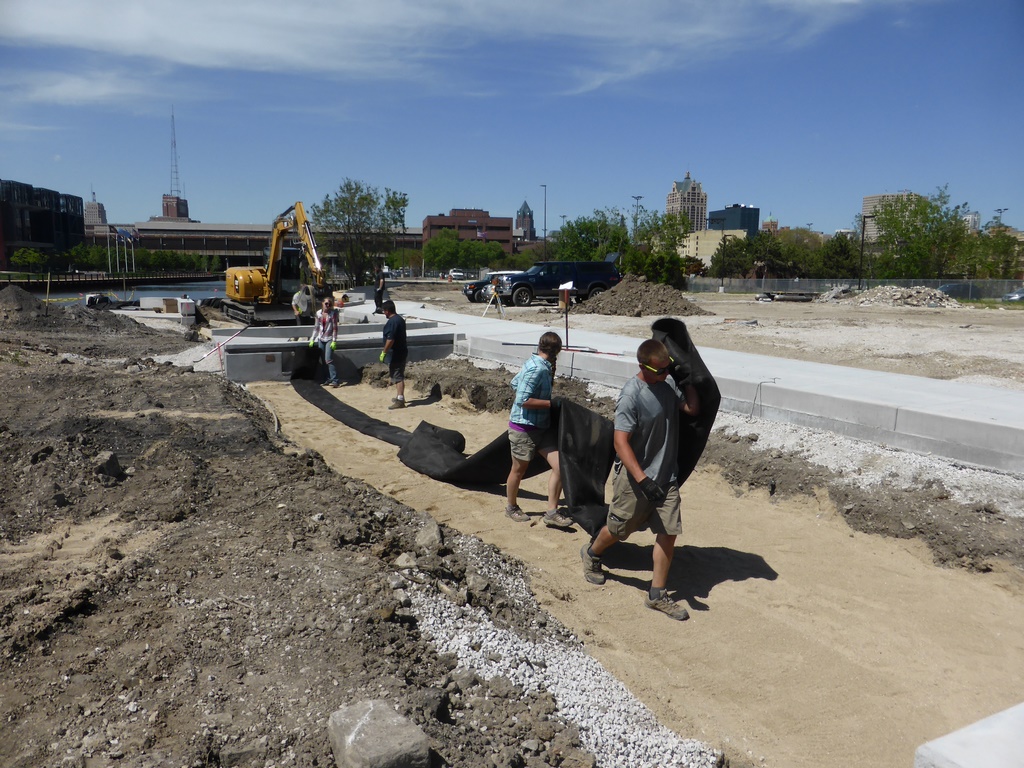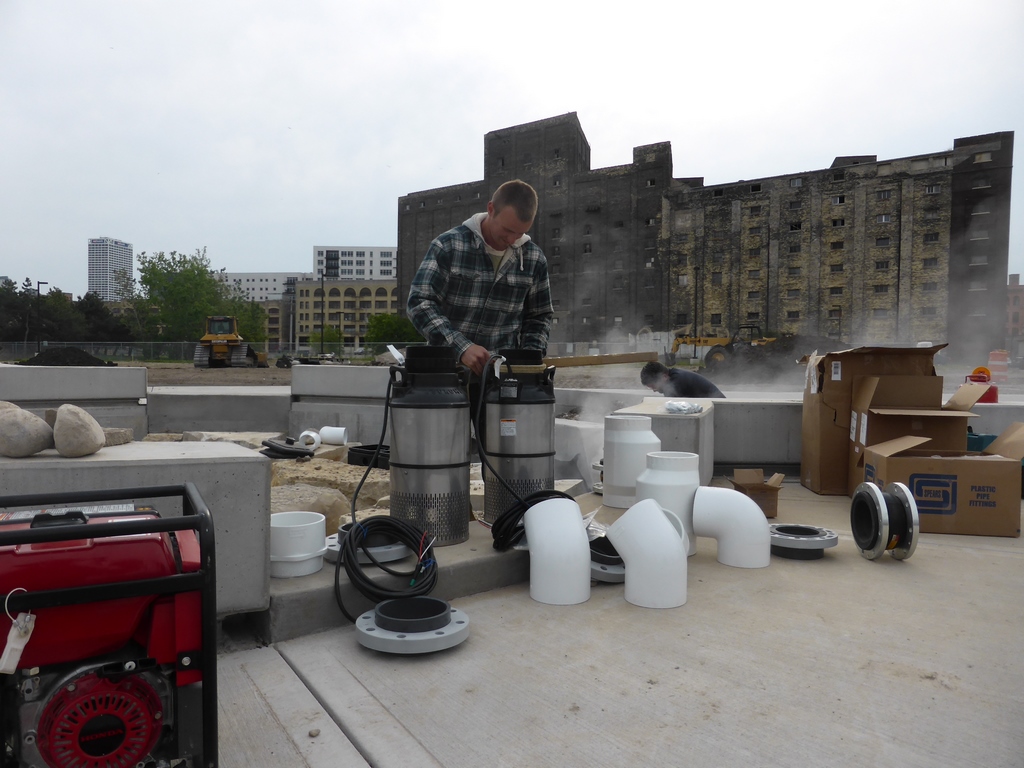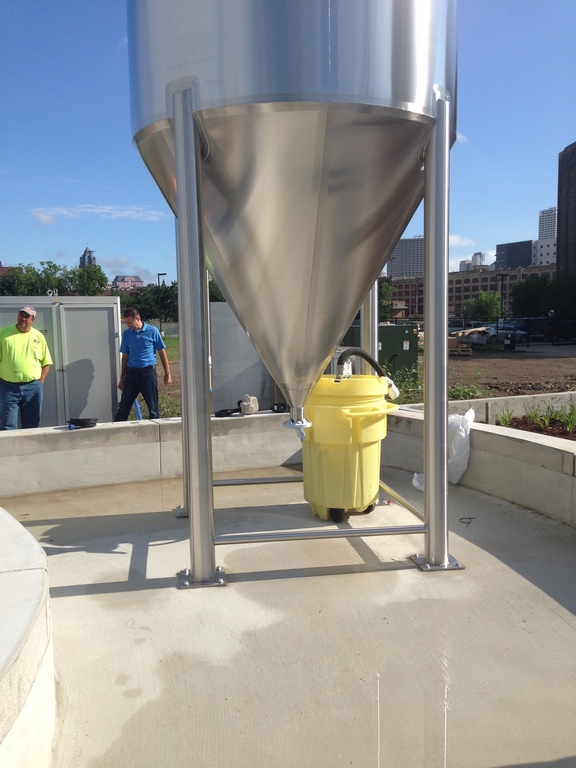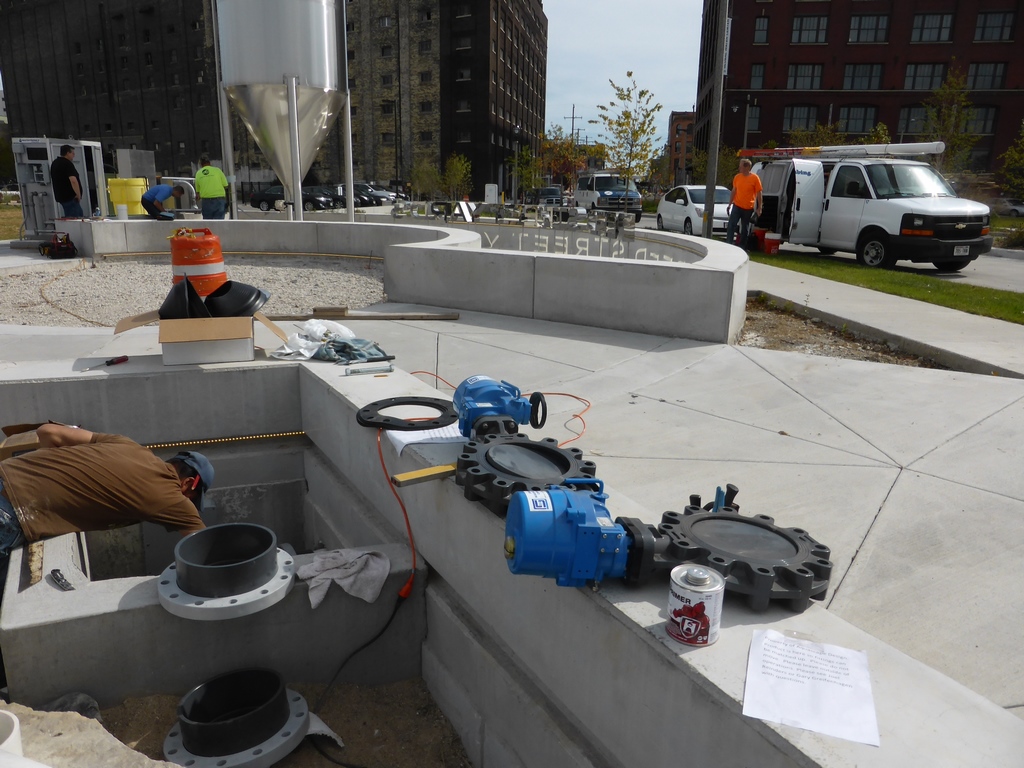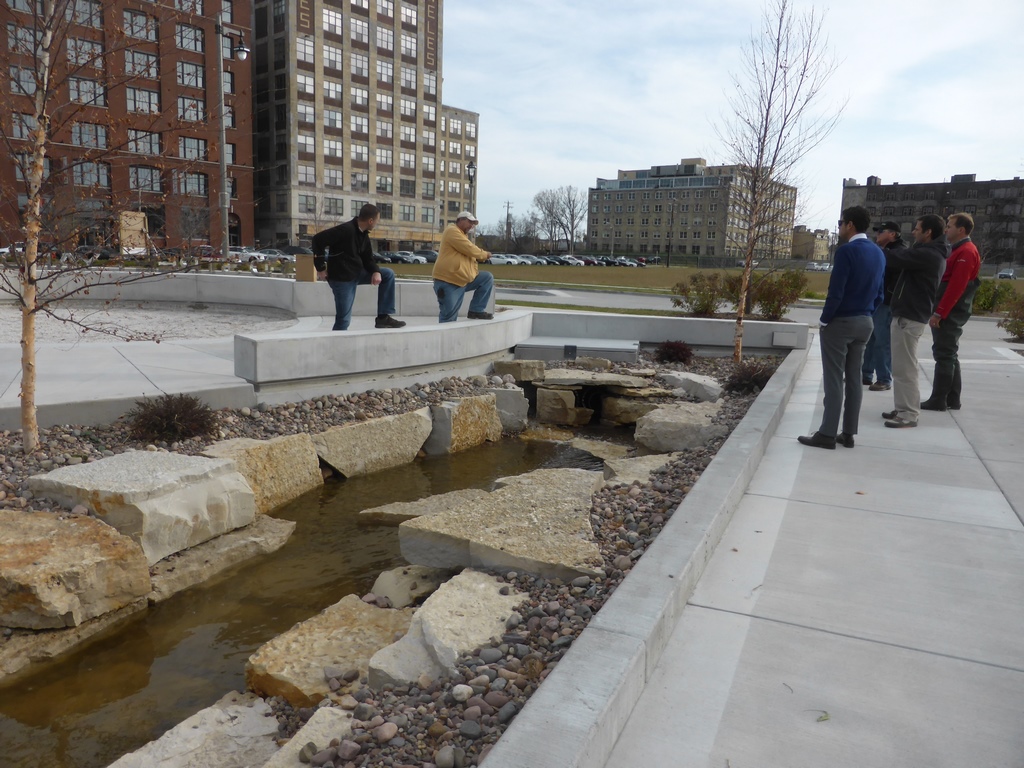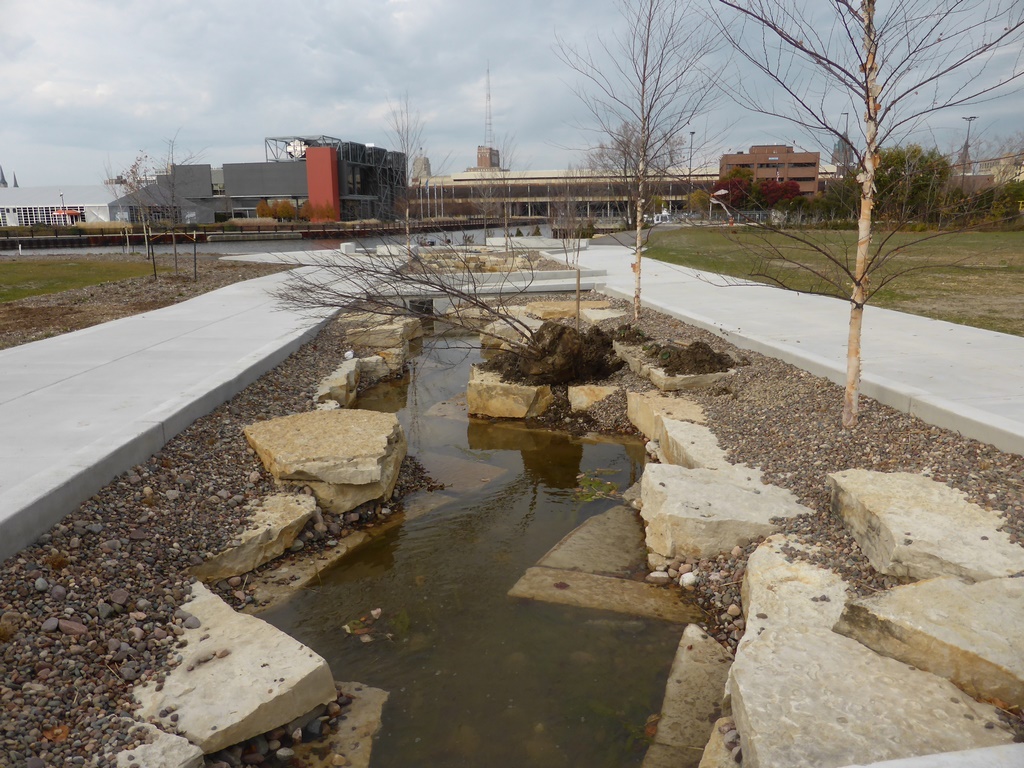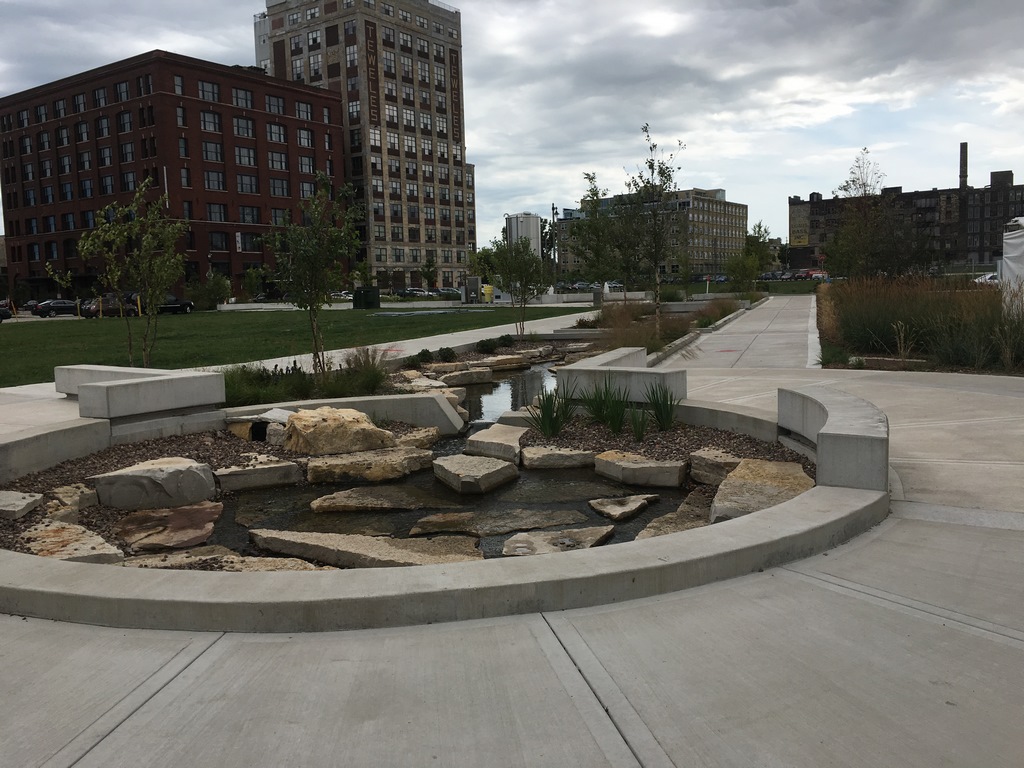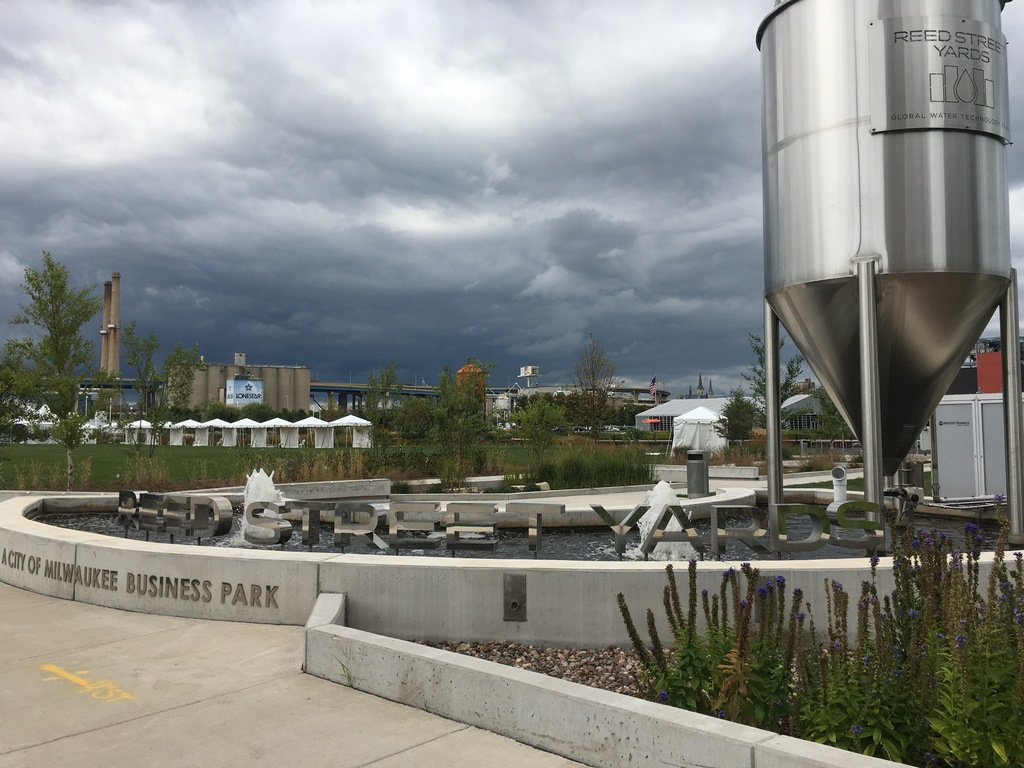Educational Flows
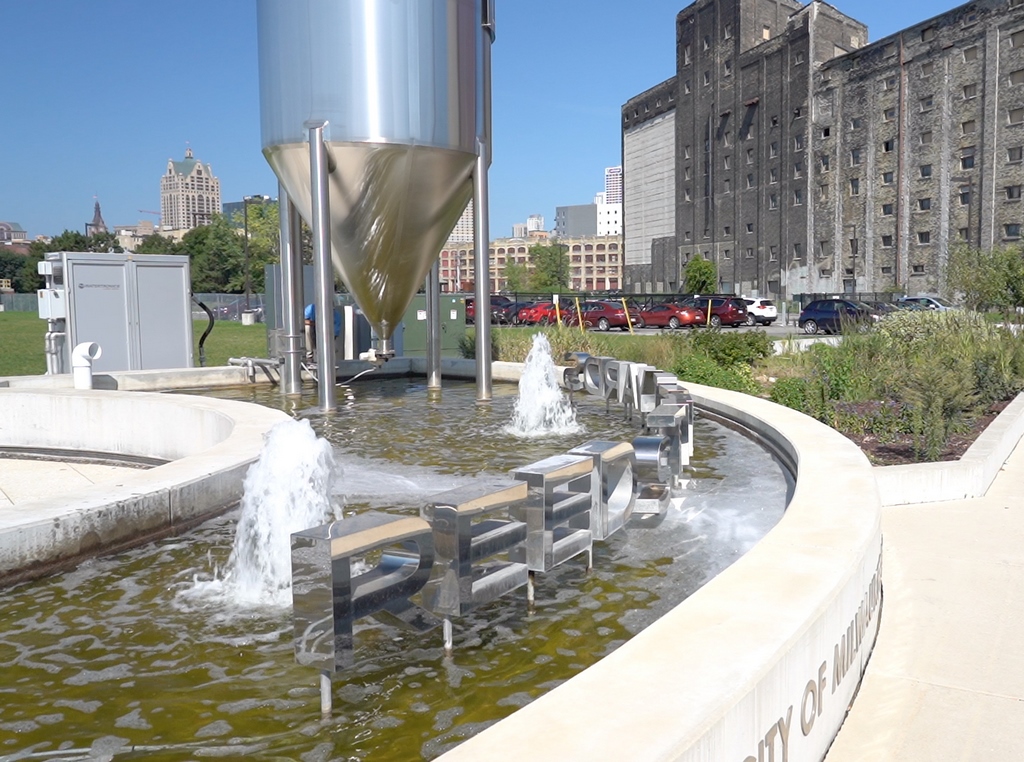
Among the most rewarding of all the projects I tackle are those in which a pond, stream or waterfall is meant to be a teaching tool. The lessons don’t have to be difficult to grasp or challenging to deliver: They simply add a layer of meaning, depth and value to the work that sharpens my interest and lifts my spirits.
The stream system at Reed Street Yards in Milwaukee, Wisc., was a source of just this form of personal satisfaction: The city has been positioning itself as a global leader in all things related to freshwater systems, and my participation here had to do with an incubator/think tank complex aimed at expanding on the efforts of the University of Wisconsin’s School of Freshwater Sciences.
The school has a facility dedicated to the study of stormwater management on the shore of the Milwaukee River about a half-mile away from the new research center and the adjacent open area that was to be our focus. I became involved through our local distributor, Reinder’s Irrigation & Supply, a family-owned business that’s operated in Wisconsin since 1866.
Joel Reinder shares my keen interest in the environment and in finding new technologies and approaches to help protect our natural resources. After a brisk set of conversations, we at Aquascape (St. Charles, Ill.) jumped in with both feet.
EMERGING IDEAS
The developer for the project had known Reinder for years and told him about his plan to create an office complex he was calling Global Water Technology Park – and, further, of his desire to have my friend help him turn the open area right next door into a demonstration site to be known as Reed Street Yards.
Reinder has connections throughout the Midwest and assembled a team of architects, engineers, general contractors and landscape and irrigation companies to address the design. He also brought me up to speed with the project and invited me to sit in with the design team. When the time came to meet, the entire group was more than ready to go: Each of us arrived loaded with ideas, and it didn’t take long for a plan to emerge.
Basically, the concept was to use the open area to demonstrate what happens when stormwater accumulates and floods an area – a situation that often arises in urban spaces when large volumes of water encounter impermeable surfaces. To do so, we would dump a large quantity of water into a headwaters basin, then watch it course through a series of downstream sections until it could go no farther and pooled in what we were calling the delta.
As the water flooded the upper basin, some of it would flow out through holes bored near the top of the basin’s walls to indicate that the system was essentially bursting at the seams. But this basin would soon begin to drain via a pair of actuator-driven butterfly valves and, within 30 minutes or so, all of the water would flow and ebb through the downstream sequence of basins, each of which would fill in turn before the entire contents of the system collected in the delta. This last basin would fill to capacity and then gradually seem to drain into a nearby water channel, after which the cycle would start over with a new burst of stormwater.
It was an involved lesson, but again, the approach made it seem accessible even to a casual viewer.
| The developer prepared our concrete structures per plan, after which we came on site and began transforming the basins into an interlinked sequence of flooding streambeds. We started at the bottom of the system, inserting a liner, connecting plumbing lines and setting up a 10,000-gallon reservoir that we called ‘the delta.’ We then worked our way upstream in a similar fashion, lining each rectangular basin and making ready for insertion of rocks and plants while keeping the channels between them clear. |
Reinder and I ran the numbers to create the desired hydraulic effect and, through his business, had access to the 12-inch butterfly valves we’d need to work in unison with a 5,000-gallon stainless steel tank that, operating as a sort of fountain, was to dump its entire contents into the already-half-full top basin all at once to flood it. The two big valves would then open, enabling the water to flow from the fountain basin into the first section of the stream at the desired (and very quick) rate.
Once on site, our stream team was involved in the extensive on-site concrete work only to the extent of making certain it would meet our needs. The developer took care of as much of the raw construction work as possible to keep costs under control, but he was happy to keep us involved so all project phases could proceed according to plan.
The one substantial challenge the site posed had to do with the soil: The new park area was being built on the former site of a manufacturing facility that left a mess behind, including a wide variety of chemical pollutants. As a consequence, we had to manage real stormwater runoff to keep these known pollutants from flowing onto any surrounding area or into the nearby canal. To exercise that control, we made certain that as much runoff as possible flowed directly into a raingarden system we inserted to control and route this water where we wanted it to go.
This involved excavation and installation of large EPDM liners that stopped local infiltration. The area would still flood, of course, but the raingardens allowed for considerable evaporative transpiration. In addition, any accumulation that exceeded system capacity was safely directed to storm sewers, thereby preventing any spreading of soil pollutants beyond the controlled area.
MAKING THE POINT
One of the key tasks on site was making the streams easy on the eye as well as extremely functional. To beautify the watercourse, we included lots of rock to create channels and direct flows in interesting ways as the system slowly began to fill before flooding. We also inserted suitable plants so everything would look great in the “dry” times between flood cycles.
In setting things up this way, Reinder and I had to consider material displacements as part of our hydraulic calculations – an unusual step in pond/stream design. As it turned out, however, the process was fairly easy because we knew the density of the stone and, aware of the tonnage we wanted to use, were able to make adjustments to compensate for its space-occupying presence.
As mentioned above, another system feature is a set of three-quarter-inch holes bored through the walls of the fountain/headwaters basin about a half-inch above the normal water level in the system. Before the big valves open to start flow through the stream, the water reaches the level of the holes and flows out via small brass decorative fittings in a sort of spitter effect.
| While we were inserting rock and gravel and completing in the circular delta, we were also sealing the liner systems within the rectangular upstream sections, wrapping up the plumbing phase and, finally, focusing on the fountain/headwaters system, with its large storage tank and the big butterfly valves that would give us control over how water would initially flow downstream. |
This water flows directly into a lined raingarden area where it is captured for reuse in our system – and on the way teaches observers about the importance of marshes and wetland vegetation as an important part of freshwater systems and the general environment.
Stepping down from the fountain basin, we used a series of channels set up within the bridges that cross the stream. These act as flow restrictors that can (and have been) adjusted slightly with stonework. As the water flows into each downstream section, it backs up to flood stage because the culverts aren’t large enough to allow for unimpeded flow. In fact, the water level will rise by about 12 inches in each section before it starts drawing down into the next section. The result is that each stream unit becomes a pond for several minutes.
Showing how this process unfolds is at the heart of the system’s messaging: We wanted to share a working demonstration of what happens around the world in urban environments where concrete and asphalt entirely cover native soil. In these places, a high percentage of impermeable surfaces creates instant runoff that really has nowhere to go – a phenomenon that simply doesn’t happen in natural ecosystems with permeable surfaces.
Once the cycle is complete, the butterfly valves close and the 10,000-gallon storage system located within the delta pumps water back to the top, half to the fountain, half to its basin, to refill both to their pre-flood water levels. If the demand for water up top exceeds what arrives in the delta, a float switch within the reservoir activates a pump located in the Milwaukee River to make up the deficit.
CLEAR COMMUNICATION
The makeup water all comes from the river, but before it becomes part of the fountain system, it flows through a micron filter and an ultraviolet sterilizing system set up by a water-purification-system manufacturer as a display feature near the top basin. But we’re pond guys, so of course we also set up small, constructed-wetland systems as part of the streambed to let biological filtration play a part.
While the overall system is essentially closed, we’re constantly filtering river water for our fountain’s functions while also cleaning it up for separate reinjection to the river via an I-beam spillway that, as mentioned above, seems to casual observers to be a direct outflow/overflow from the delta (but isn’t).
I’m particularly pleased to have played a direct role in developing the project’s educational component. All of the exposed equipment near the fountain is fully functional rather than merely for display, which is great, and I had a hand in drafting the explanatory signage that now appears alongside the system from end to end.
| Once water drawn from the reservoir has flowed up to refill the storage tank and headwaters basin, the tank opens with a torrent that initiates a flood cycle: The water rises to a level where water spits out of holes in the basin walls, at which point the butterfly valves open and water starts flowing toward the delta. Each stream swells and overtops its ‘banks’ in turn as water moves along, delivering a succinct lesson – explained in signage along the watercourse – about what happens in nature when stormwater meets impermeable surfaces in urban environments. Once the water settles into the reservoir, the cycle starts again. |
A few times each year, the area also hosts special events, during which docents are on hand to add depth to the signage. For example, there’s a Green Festival held at an adjacent property along the river each summer, putting Reed Street Yards in the middle of the action along a street appropriately called Freshwater Way.
Adding to the exposure is the presence on the riverbank opposite Reed Street Yards of the Harley Davidson Museum; the historic Iron Horse Hotel is nearby as well. In fact, the whole area is seeing growth and redevelopment as old riverfront warehouses are being converted to office and residential space, and there’s an increasingly popular pedestrian walkway along the shoreline as well.
Our role in beautifying the space and contributing to the development’s potential is a source of great satisfaction, but for me, everything jumped up a notch because of the instructive messages conveyed by Reed Street Yards and the way so many people with diverse interests came together to create an interesting, engaging educational space.
Many of our projects at Aquascape are about sustainable resource management, but it’s rare and wonderful to participate in one that shows our concern and tells an important story so clearly. To this day, in fact, just thinking about what we all accomplished here brings a smile to my face.
Ed Beaulieu is director of contractor development and field research for Aquascape, Inc., St. Charles, Ill. For more information, visit www.aquascapeinc.com.














